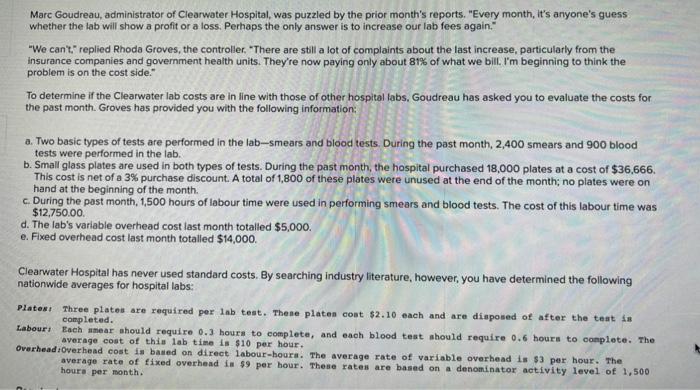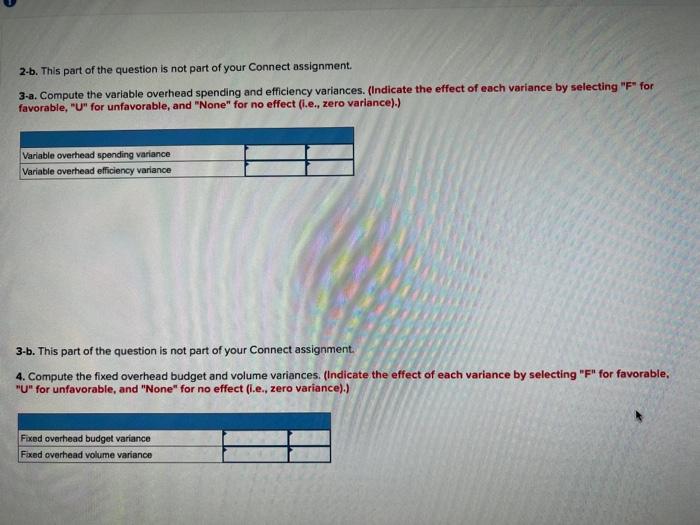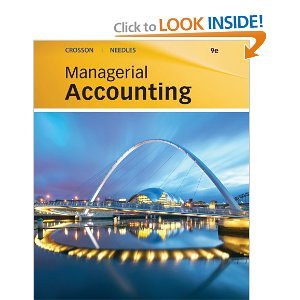Marc Goudreau, administrator of Clearwater Hospital, was puzzled by the prior month's reports. "Every month, it's anyone's guess whether the lab will show a profit or a loss. Perhaps the only answer is to increase our lab fees again." "We can't," replied Rhoda Groves, the controller. "There are still a lot of complaints about the last increase, particularly from the insurance companies and government health units. They're now paying only about 81% of what we bill. I'm beginning to think the problem is on the cost side." To determine if the Clearwater lab costs are in line with those of other hospital labs. Goudreau has asked you to evaluate the costs for the past month. Groves has provided you with the following information: a. Two basic types of tests are performed in the lab-smears and blood tests. During the past month, 2,400 smears and 900 blood tests were performed in the lab. b. Small glass plates are used in both types of tests. During the past month, the hospital purchased 18,000 plates at a cost of $36,666. This cost is net of a 3% purchase discount. A total of 1,800 of these plates were unused at the end of the month; no plates were on hand at the beginning of the month. c. During the past month, 1,500 hours of labour time were used in performing smears and blood tests. The cost of this labour time was $12,750.00. d. The lab's variable overhead cost last month totalled $5,000. e. Fixed overhead cost last month totalled $14,000. Clearwater Hospital has never used standard costs. By searching industry literature, however, you have determined the following nationwide averages for hospital labs: Platest Three plates are required per lab test. Thene platen cont $2.10 each and are diaposed of after the teat ia Labours conpleted. Eaca amear ahould require 0.3 houra to complete, and each blood teat ahould require 0.6 hours to oonplete. The overheedioverage cont of thin lab tine is $10 per hour. averaged cost is bailed on direct labour-boura. The average rate of variable overhead is $3 per hour. The houre per month. natomwide averages ror nospitai iabs. Platert. Three plates are required per lab test. These plates cost 52.10 each and are diaposed of after the teat in Labourt Baoh mear should require 0.3 houra to complete, and each blood teat ahould require 0.6 hour to eonplete. The opepleted. average cost of thia lab time is $10 per hour. overhead roverhead cost is based on direct labour-houra. The average rate of variable overhead is $3 per hour. The average rate of fixed overhead is $9 per hour. Thea rates are based on a denominator activity level of 1 , 500 . hours per nonth. Required: 1. Compute the materials price variance for the plates purchased last month, and compute a materials quantity variance for the plates used last month. (Indicate the effect of each variance by selecting "F" for favorable, "U" for unfavorable, and "None" for no effect (Le., zero variance).) 2-a. Compute a labour rate variance and a labour efficiency variance for the lab. (Indicate the effect of each variance by selecting "F" for favorable, "U" for unfavorable, and "None" for no effect (i.e., zero variance). Do not round intermediate calculation and round your final answers to 1 decimal place.) 2-b. This part of the question is not part of your Connect assignment. 3-a. Compute the variable overhead spending and efficiency variances. (Indicate the effect of each variance by selecting "F" for favorable, "U" for unfavorable, and "None" for no effect (i.e., zero variance).) 3-b. This part of the question is not part of your Connect assignment. 4. Compute the fixed overhead budget and volume variances. (Indicate the effect of each variance by selecting "F" for favorable, "U" for unfavorable, and "None" for no effect (i.e., zero variance).)









